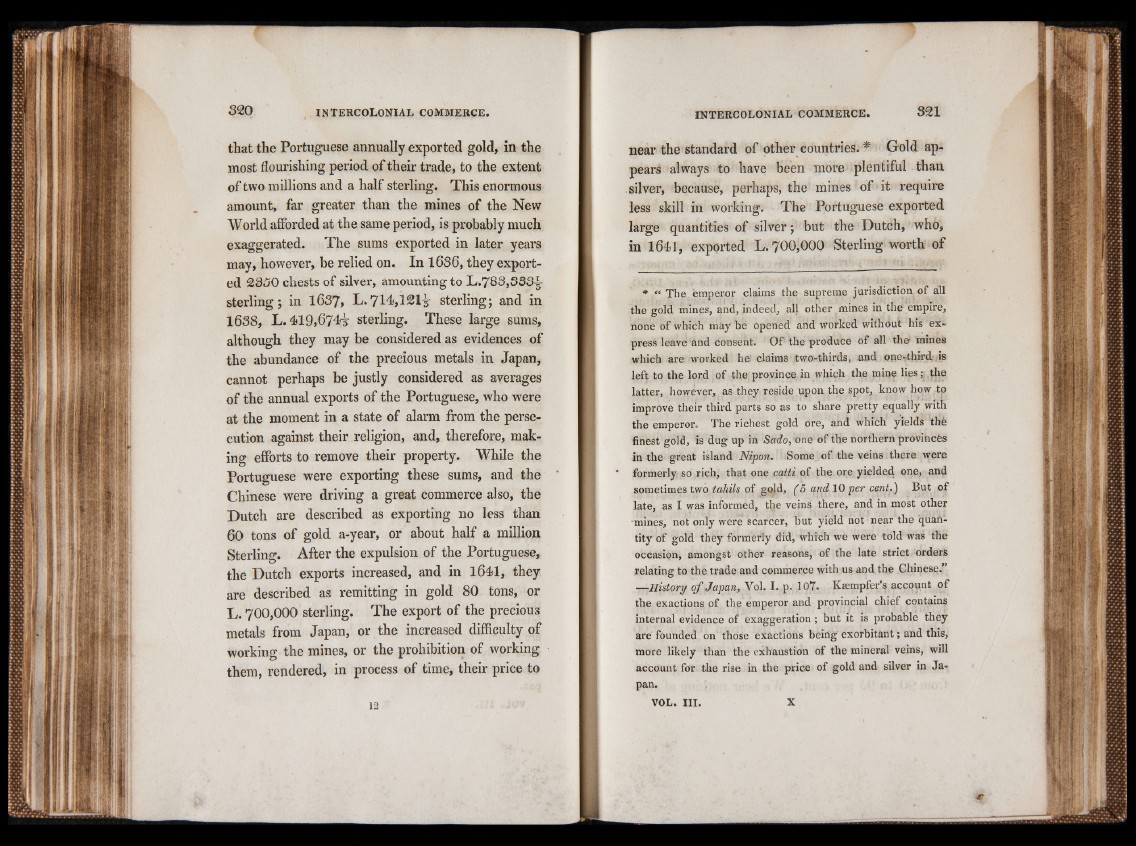
that the Portuguese annually exported gold, in the
most flourishing period of their trade, to the extent
of two millions and a half sterling. This enormous
amount, far greater than the mines of the New
"World afforded at the same period, is probably much
exaggerated. The sums exported in later years
may, however, be relied on. In 1636, they exported
2350 chests of silver, amounting to L.783,3S5i-
sterling; in 1637, L. 714,121^ sterling; and in
1638, L. 419,674i sterling. These large sums,
although they may be considered as evidences of
the abundance of the precious metals in Japan,
cannot perhaps be justly considered as averages
of the annual exports of the Portuguese, who were
at the moment in a state of alarm from the persecution
against their religion, and, therefore, making
efforts to remove their property. While the
Portuguese were exporting these sums, and the
Chinese were driving a great commerce also, the
Dutch are described as exporting no less than
60 tons of gold a-year, or about half a million
Sterling. After the expulsion of the Portuguese,
the Dutch exports increased, and in 1641, they
are described as remitting in gold 80 tons, or
L. 700,000 sterling. The export of the precious
metals from Japan, or the increased difficulty of
working the mines, or the prohibition of working
them, rendered, in process of time, their price to
12
near the standard of other countries. * Gold appears
always to have been more plentiful than
silver, because, perhaps, the mines of it require
less skill in working. The Portuguese exported
large quantities of silver; hut the Dutch, who,
in 1641, exported L. 700,000 Sterling worth of
* The femperor claims the supreme jurisdiction of all
the gold mines, and, indeed, all other mines in the) empire,
none of which may he opened arid worked without his express
leave and consent. Of the produce of all the mines
which are worked he claims -two-thirds, and one-third;.-is
left to the lord of the province in which the mine lies ; the
latter, however, as they reside upon the spot, know how to
improve their third parts so as to share pretty equally with
the emperor. The richest gold ore, arid which yields thè
finest gold, is dug up in Sado, one of the northern provincès
in the great island Nipon. Some /Of the veins there were
formerly so rich, that one catti of the ore. yielded one, and
sometimes two tahils of gold, (5 and 10 per cent.) But of
late, as I was informed, the veins there, and in most other
■mines, not only were scarcer, but yield not near the quantity
of gold they formerly did, Which we were told was the
occasion, amongst other reasons, of the late strict orders
relating to the trade and commerce with us and the Chinese.”
— History of Japan, Vol. I. p. 107. Kaempfer’s account of
the exactions of the emperor and provincial chief contains
internai evidence of exaggeration ; but it is probablè they
are founded on those exactions being exorbitant ; and this,
more likely than the exhaustion of the mineral veins, will
account for the rise in the price of gold and silver in Japan
.V
OL. III. X